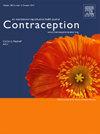希望永久避孕的产后患者考虑长效可逆避孕的患者和妇产科观点
IF 2.8
2区 医学
Q1 OBSTETRICS & GYNECOLOGY
引用次数: 0
摘要
目的:我们试图了解患者和妇产科医生在寻求或推荐长效可逆避孕方法(LARC;当永久避孕是患者最初的首选避孕措施时,在产后期间,宫内节育器和避孕植入物)与永久避孕。研究设计:我们采访了来自美国四家机构的81名希望永久避孕的产后患者及其接生的妇产科医生(n=67),以探讨患者和妇产科医生对永久避孕咨询和决策的看法。我们使用NVivo 12 Pro软件对访谈记录进行专题内容分析。结果:我们的分析显示,在考虑永久避孕和LARC时,患者和妇产科的优先级不匹配。在我们的研究中,许多妇产科医生描述了对LARC方法的偏好,而不是永久性避孕,并且通常优先考虑可逆性和月经抑制等因素。然而,许多患者寻求永久避孕的原因是LARC方法不能充分解决的,如方法永久性,希望避免月经抑制,癌症预防,既往使用LARC的负面经历,以及偏好避免异物。这些结果表明,选择首选避孕方法的优先顺序有时可能与患者和临床医生不一致,并且LARC方法可能并不总是希望永久避孕的患者可接受的替代方法。这项研究的结果强调了在避孕咨询期间引导和集中患者的目标和追求永久避孕的愿望的重要性。临床医生应该意识到患者对这些方法的不同观点和价值观,并将其纳入以患者为中心的共享决策。本文章由计算机程序翻译,如有差异,请以英文原文为准。
Patient and obstetrician-gynecologist perspectives on considering long-acting reversible contraception for postpartum patients who desire permanent contraception
Objective(s)
We sought to understand patients’ and obstetrician-gynecologists’ priorities in seeking or recommending long-acting reversible contraceptive methods (LARC; intrauterine devices and contraceptive implants) versus permanent contraception in the postpartum period when permanent contraception was the patient’s initial contraceptive preference.
Study design
We interviewed 81 postpartum patients who desired permanent contraception and their delivering obstetrician-gynecologist (n = 67) from four US institutions to explore patient and obstetrician-gynecologist (OBGYN) perspectives navigating permanent contraception counseling and decision-making. We used thematic content analysis to analyze interview transcripts using NVivo 12 Pro software.
Results
Our analysis revealed a mismatch between patient and OBGYN priorities when considering permanent contraception versus LARC. Many OBGYNs in our study described a preference for LARC methods over permanent contraception and often prioritized factors such as reversibility and menstrual suppression. However, many patients sought permanent contraception for reasons that were not adequately addressed by LARC methods such as method permanence, desire to avoid menstrual suppression, cancer prevention, prior negative experiences with LARC, and a preference to avoid a foreign body.
Conclusion(s)
These results suggest that priorities in selecting a preferred contraceptive method may sometimes not be aligned between patients and clinicians and that LARC methods may not always be an acceptable alternative for patients who desire permanent contraception. The findings from this study highlight the importance of eliciting and centering a patient’s goals and desires for pursuing permanent contraception during contraceptive counseling. Clinicians should be aware of the various perspectives and values patients have on these methods and include them in patient-centered share decision-making.
Implications
Our study revealed a large discrepancy between patient and obstetrician-gynecologist priorities in seeking or recommending permanent contraception. Clinicians must avoid making assumptions about a patient’s priorities for a contraceptive choice to engage in truly patient-driven contraceptive counseling.
求助全文
通过发布文献求助,成功后即可免费获取论文全文。
去求助
来源期刊

Contraception
医学-妇产科学
CiteScore
4.70
自引率
17.20%
发文量
211
审稿时长
69 days
期刊介绍:
Contraception has an open access mirror journal Contraception: X, sharing the same aims and scope, editorial team, submission system and rigorous peer review.
The journal Contraception wishes to advance reproductive health through the rapid publication of the best and most interesting new scholarship regarding contraception and related fields such as abortion. The journal welcomes manuscripts from investigators working in the laboratory, clinical and social sciences, as well as public health and health professions education.
 求助内容:
求助内容: 应助结果提醒方式:
应助结果提醒方式:


